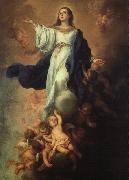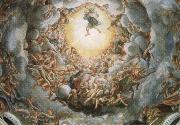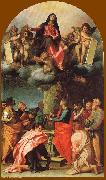
Oil On
Canvas, Real Flavor of Old Masters
|
Bartolome Esteban Murillo
|
|||
|
|
|||
| Spanish 1618-1682 Bartolome Esteban Murillo Galleries Murillo began his art studies under Juan del Castillo in Seville. Murillo became familiar with Flemish painting; the great commercial importance of Seville at the time ensured that he was also subject to influences from other regions. His first works were influenced by Zurbaran, Jusepe de Ribera and Alonso Cano, and he shared their strongly realist approach. As his painting developed, his more important works evolved towards the polished style that suited the bourgeois and aristocratic tastes of the time, demonstrated especially in his Roman Catholic religious works. In 1642, at the age of 26 he moved to Madrid, where he most likely became familiar with the work of Velazquez, and would have seen the work of Venetian and Flemish masters in the royal collections; the rich colors and softly modeled forms of his subsequent work suggest these influences. He returned to Seville in 1645. In that year, he painted thirteen canvases for the monastery of St. Francisco el Grande in Seville which gave his reputation a well-deserved boost. Following the completion of a pair of pictures for the Seville Cathedral, he began to specialise in the themes that brought him his greatest successes, the Virgin and Child, and the Immaculate Conception. After another period in Madrid, from 1658 to 1660, he returned to Seville. Here he was one of the founders of the Academia de Bellas Artes (Academy of Art), sharing its direction, in 1660, with the architect, Francisco Herrera the Younger. This was his period of greatest activity, and he received numerous important commissions, among them the altarpieces for the Augustinian monastery, the paintings for Santa Mar??a la Blanca (completed in 1665), and others. | |||
|
|
|||
|
|
Assumption of the Virgin Bartolome Esteban Murillo4.jpg Painting ID:: 2769 Visit European Gallery |
c1678 Museo del Prado, Madrid | |
Height Width |
INS/CM |
||
|
X |
|
||
|
|
|||
|
Correggio
|
|||
|
|
|||
| Italian 1489-1534 Correggio Locations Italian painter and draughtsman. Apart from his Venetian contemporaries, he was the most important northern Italian painter of the first half of the 16th century. His best-known works are the illusionistic frescoes in the domes of S Giovanni Evangelista and the cathedral in Parma, where he worked from 1520 to 1530. The combination of technical virtuosity and dramatic excitement in these works ensured their importance for later generations of artists. His altarpieces of the same period are equally original and ally intimacy of feeling with an ecstatic quality that seems to anticipate the Baroque. In his paintings of mythological subjects, especially those executed after his return to Correggio around 1530, he created images whose sensuality and abandon have been seen as foreshadowing the Rococo. Vasari wrote that Correggio was timid and virtuous, that family responsibilities made him miserly and that he died from a fever after walking in the sun. He left no letters and, apart from Vasari account, nothing is known of his character or personality beyond what can be deduced from his works. The story that he owned a manuscript of Bonaventura Berlinghieri Geographia, as well as his use of a latinized form of Allegri (Laetus), and his naming of his son after the humanist Pomponius Laetus, all suggest that he was an educated man by the standards of painters in this period. The intelligence of his paintings supports this claim. Relatively unknown in his lifetime, Correggio was to have an enormous posthumous reputation. He was revered by Federico Barocci and the Carracci, and throughout the 17th and 18th centuries his reputation rivalled that of Raphael. | |||
|
|
|||
|
|
Assumption of the Virgin new4/Correggio-668534.jpg Painting ID:: 30482 Visit European Gallery |
mk68 Fresco Parma,Parma Cathedral 1526-1530 Italy | |
Height Width |
INS/CM |
||
|
X |
|
||
|
|
|||
|
Andrea del Castagno
|
|||
|
|
|||
| Italian c1421-1457 Andrea del Castagno Location Italian c1421-1457 Andrea del Castagno Location Italian painter. He was the most influential 15th-century Florentine master, after Masaccio, of the realistic rendering of the figure and the representation of the human body as a three-dimensional solid by means of contours. By translating into the terms of painting the statues of the Florentine sculptors Nanni di Banco and Donatello, Castagno set Florentine painting on a course dominated by line (the Florentine tradition of disegno), the effect of relief and the sculptural depiction of the figure that became its distinctive trait throughout the Italian Renaissance, a trend that culminated in the art of Michelangelo. | |||
|
|
|||
|
|
Assumption of the Virgin new4/Andrea del Castagno-524742.jpg Painting ID:: 32228 Visit European Gallery |
1529 Panel, 239 x 209 cm | |
Height Width |
INS/CM |
||
|
X |
|
||
|
|
|||
|
El Greco
|
|||
|
|
|||
| Greek-born Spanish Mannerist Painter, 1541-1614 Considered a representative of late Renaissance Spanish art, El Greco was actually born in Greece, on the island of Crete. After studying in Venice under Titian, El Greco settled in Toledo, Spain in 1577. At the time he was wildly popular, his emotionally religious paintings being just the ticket for the hometown of the Spanish Inquisition. After his death his work was largely ignored until the beginning of the 20th century; now he considered one of the inspired geniuses of Western art. His distinctive style features bold shapes and colors, with elongated and slightly distorted figures. In Toledo El Greco was in constant demand and liked living large: he maintained a private orchestra to accompany his meals. | |||
|
|
|||
|
|
Assumption of the Virgin new9/El Greco-627566.jpg Painting ID:: 32873 Visit European Gallery |
mk84 1577-79 | |
Height Width |
INS/CM |
||
|
X |
|
||
|
|
|||










